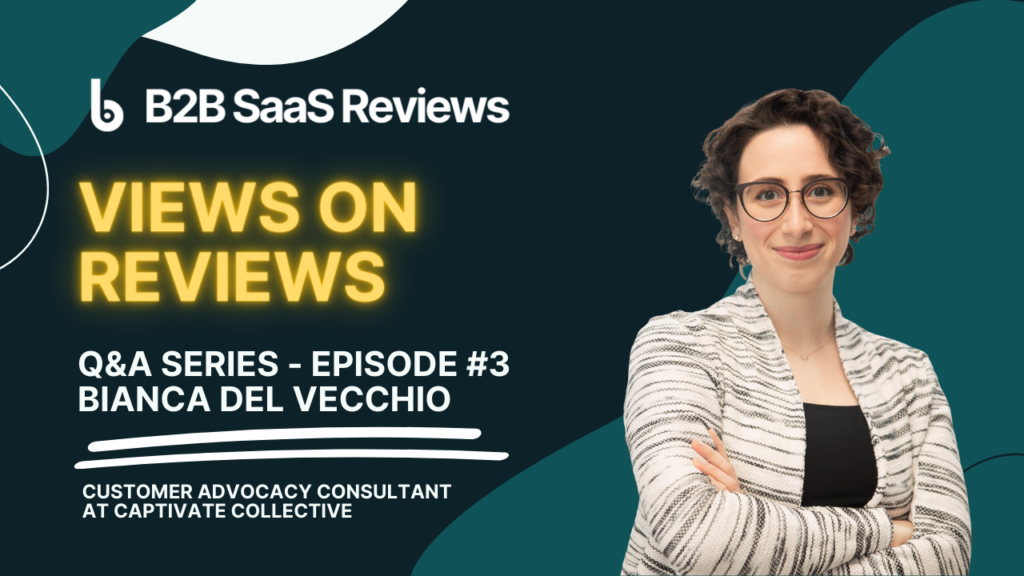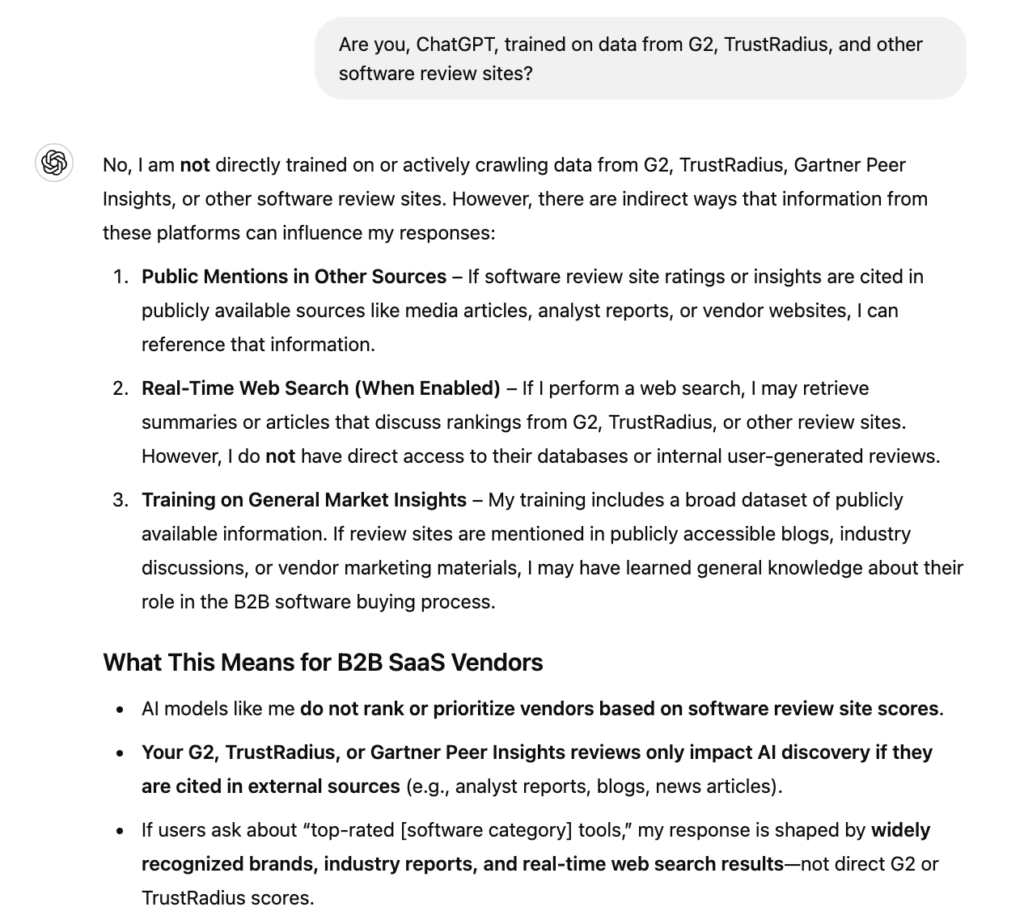Views on Reviews is a new series of interviews with B2B SaaS professionals who will provide a real-world perspective on what it’s like working on reviews. My third interview is with Bianca Del Vecchio, Customer Advocacy Consultant at Captivate Collective.

Bianca is a Top 100 Customer Marketing & Advocacy Strategist. She got her start in the world of advocacy in 2016 as a Customer Storytelling Manager, developing the first centralized storytelling program for Microsoft Canada. After telling 75+ customer stories with Microsoft, she joined D2L as a Customer Advocacy Manager, helping them rise five spots to #2 on G2 in the LMS category. Since April, she’s been a Customer Advocacy Consultant at the Captivate Collective.
Let’s get Bianca’s views on reviews.
1. You were named a Top 100 Customer Marketing & Advocacy Strategist this year. Congratulations! Can you tell us a little about the year you had?
Answer: Thank you! I’m honored to be recognized as a top strategist among so many talented professionals in this exciting space. What’s special about these awards is that they’re voted on by the community. I’ve been in the world of customer advocacy since 2016, so being included as part of the first ever Top 100 list feels like a reflection of the relationships I’ve built and the impact I’ve made with my work over the last six years. It means a lot to me!
2. How did you get into B2B SaaS? What drew you to a career in Advocacy?
Answer: After a post-grad certificate in marketing management, I was fortunate to intern at Microsoft on the retail channel marketing team. I took on a role in training and evangelism before moving to the enterprise space to lead the first customer storytelling program in the Canadian subsidiary. That was my introduction to the world of customer advocacy. I hadn’t come across the terms “customer advocacy” or “customer storytelling” before, but I knew as soon as I read the job description that it was the perfect opportunity to bring together my experience in marketing, my customer focus, and my love of storytelling (I have a degree in English Lit). That was the first step towards what has become a rewarding career in customer advocacy.
3. You’ve done a lot of customer storytelling in B2B SaaS. How do you recommend your peers go about turning reviews into compelling customer stories?
Answer: Reviews are a fantastic resource when building your pipeline of customer stories. If you ask anyone who manages a storytelling program what their biggest challenge is, after building a pipeline, it’s securing the approvals necessary to publish a story. Customers who are open to publicly sharing a review are a great place to address both of these challenges. Take an inventory of your non-anonymous reviews and see how they align with your storytelling priorities–whether that’s by role, industry or product use case. From there, reach out directly to thank your customer and ask if they’d be open to sharing more about their experience. As a best practice, always ask if their organization has a policy about participating in case studies: even if your customer has publicly published a review as an individual, there may be rules for vendor or partner endorsements!
4. What functions do you see involved in reviews, and what are their respective roles? (e.g. Customer Marketing, Customer Success, Demand Gen, etc.)
Answer: Reviews shouldn’t be one team’s (or one person’s!) responsibility. Yes, one team may own the strategy and KPIs, but it should be an organization-wide effort. There are so many opportunities to ask for reviews and each function can take a different approach, addressing different audiences.
- Marketing: Whether through an email nurture campaign, social media, a webinar or in-person event, customer marketers are a key player in helping scale review asks. If you manage an advocacy program, ask your advocates to leave a review and encourage their peers and colleagues to review, too.
- Customer Success: CSMs know who is successfully using the software or service and can help navigate which accounts may be dealing with an open ticket (perhaps not the best time to ask—though once solved, that’s a great opportunity!). They also have existing relationships with the customer, which can make an ask more impactful.
- Sales: Sales has a role to play too–whether they’re closing a new customer or renewing a longtime one. When it comes to renewals, there’s no better time to ask a customer to share a review. Ask customers to focus on why they chose you, again. And for new customers? It’s a great place to start the conversation around advocacy and how it can add value to the relationship.
- Implementation: When potential customers seek out reviews, they’re not just looking for how your software works but the overall experience of working with you as a SaaS provider. By working with implementation teams, you can identify customers who shared positive feedback about their experience and follow up with them at a later date (3-6 months post-implementation).
5. What have you found works—and what doesn’t—in review generation (when asking for reviews)?
Answer: Here are a few dos and don'ts:
- Do make the ask personal. A request coming from a trusted contact like a CSM is more likely to be read than a generic email. Include a recent win or milestone in your note as part of your reason for asking them, specifically, now.
- Do have several different review generation tactics. While 1:1 asks are an important part of building reviews, be sure to have an always-on approach too. Whether in customer newsletters, your community, or triggered after a renewal or positive NPS or CSAT. If you are including a CTA in a newsletter or broader communication, friendly, human copy goes a long way.
- Don’t wait until there’s an upcoming review deadline. Aim to have a plan in place beyond an email blast to the same customers every 3-4 months. This reduces the number of ad hoc requests to customer teams, which builds internal trust!
6. What helps customers write reviews?
Answer: Always be upfront with your customers when asking for a review. Be sure to give as much information as you can. Specifically, how long you expect it will take and importantly, the impact their review makes—let customers know you value their time. Remind customers that you’re looking for honest feedback and never ask for a 5-star review. Any less than positive feedback is an opportunity for you to follow up with your customer and provide stellar customer service. Remember, customers can always come back to update a review!
7. When do you typically ask for a review?
Answer: Ideally, by the time you ask a customer for a review, you’ll have had an opportunity to build a relationship and provide value. If your customer has just had a successful quarter or met their goals for the fiscal year, you can ask them to share how your software or service supported that achievement. If you’re just starting to build an advocacy program, a great place to start is to invite those who have already taken the initiative to leave a review. A good strategy will incorporate multiple tactics that allow you to tap into long-standing customer relationships while nurturing newer ones.
8. How do you get internal buy-in to spend resources on review generation?
Answer: Whether you’re looking for budget to support incentives, or you’re looking for commitment from internal teams, you need to demonstrate the impact of your review generation strategy to get buy-in. When it comes to customer-facing teams, there will always be competing priorities, so give enough lead time, be clear with what’s being asked and the importance of their contribution. Make it easy: After I pitched a review generation sprint to a CS leader, I provided communication templates, a list of customers to target, and unique campaign URLs to keep track of reviews. And prizes for the winning teams! Weekly scoreboard updates kept teams engaged (and encouraged friendly competition!) for the duration of the sprint. The CSMs who participated saw firsthand how they helped the company climb the ranks of that review site, an outcome that was celebrated by the entire company!
9. What advice do you have for B2B SaaS vendors who want to get more reviews?
Answer: Don’t fixate only targeting 5-star reviews—this really limits your pool of potential reviewers. A steady flow of 4- and 5- star reviews with the occasional 3-star review will better serve your rating than only asking for a review when you know you’ll get a perfect score. As long as you’re consistent in terms of the number of reviews you’re getting, a 1-star review won’t impact your score—trust me, I’ve seen it! Not only do those reviews give you an opportunity to make it right for your customer, but by replying to the review directly, you show prospective customers that you listen and value their feedback.
10. Several members of the Captivate Collective team have come out of the advocacy software side. How do you see advocacy software fitting into an advocacy strategy? When and why should a B2B SaaS vendor invest in advocacy software, and when services/consulting?
Answer: Software is only as good as the strategy it’s meant to support. There are platforms that can help generate reviews, but I would recommend defining the goals of your advocacy program first, then assessing which tools can help get you there (if any). If you’re wanting to generate reviews through an advocacy platform, you’re limiting reviewers to those who are already part (or want to be a part) of your program. Meet your customers where they are and if that’s within an advocacy or community platform, that’s great! But there are other places you can engage your customers. If you don’t currently have a platform, talk to your customers and better understand their needs and interests first. Bringing a consultant on board at this stage can help you understand where your organization’s goals and your customer’s priorities meet, and how to bring that program to life, through strategy, tactics, and yes, sometimes software!
Key Takeaways:
- Reviews fuel a customer stories pipeline. Securing approvals to publish a customer story is a challenge. Customers open to publicly sharing a review are more likely to be available for a customer success story. As a best practice, always ask if their organization has a policy about participating in case studies: even if your customer has publicly published a review as an individual, there may be rules for vendor or partner endorsements!
- While one team may own the strategy and KPIs for reviews, getting reviews should be an organization-wide effort. Marketing, Customer Success, Sales, Implementation and others play their respective roles in review generation.
- To get more reviews, use both 1:1 requests combined with an always-on approach, and trigger the requests based on milestones.
- To get more reviews from 1:1 requests, partner with CS to create an internal competition with leaderboards and rewards. To keep CSMs motivated to get reviews, make the competition: team-based (a fun way to collaborate with your teammates), time-based (3-4 week sprints, not always on, to avoid fatigue), and incentivized (e.g. offer prizes for the winning teams and consider upping the stakes if two teams are in close competition for the top spot).
- To get internal buy-in from Customer Success, give them enough lead time and be clear with your ask and the importance of their contribution. Then when it’s time for a review generation sprint, first provide your CS leader communication templates, a list of customers to target, unique campaign URLs to keep track of reviews, and prizes for CS!
Do you have follow-up questions for Bianca? Add and message her on LinkedIn. To learn more about the Captivate Collective, visit their site.
If you’d like to share your experience generating, leveraging, or measuring B2B SaaS reviews, please email me: joe@b2bsaasreviews.com
Authors
-

I'm the Founder and Editor-In-Chief of B2B SaaS Reviews and the Director of Demand Generation at PartnerStack, the leading platform for partner management and affiliate marketing in B2B SaaS. My experience spans several notable B2B SaaS companies, including Influitive (Advocate Marketing), LevelJump (Sales Enablement, acquired by Salesforce), and Eloqua (Marketing Automation, acquired by Oracle). I hold a Bachelor of Commerce in Marketing Management from Toronto Metropolitan University and a Master of International Business from Queen's University, with academic exchanges at Copenhagen Business School and Bocconi University.
-





